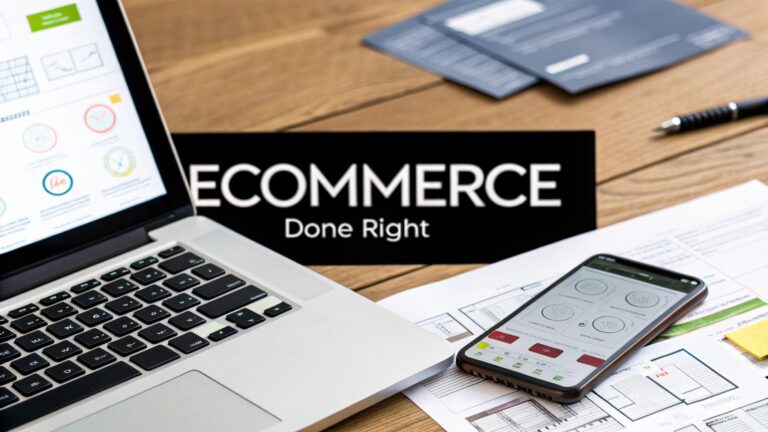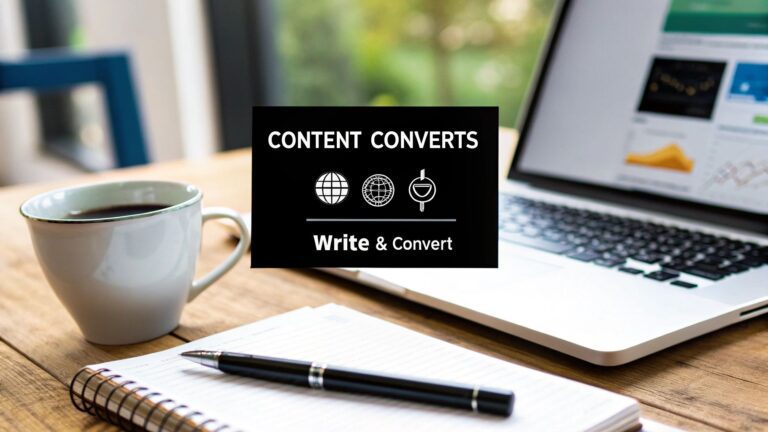Think of social media marketing as more than just posting updates. For small businesses in the UK, it's about using platforms like Instagram, Facebook, and LinkedIn to forge real connections with customers, build a memorable brand, and ultimately, drive sales. It’s genuinely one of the most cost-effective ways to reach a huge, specific audience, even if you’re working with a tight budget.
Why Social Media Is Your Business Superpower
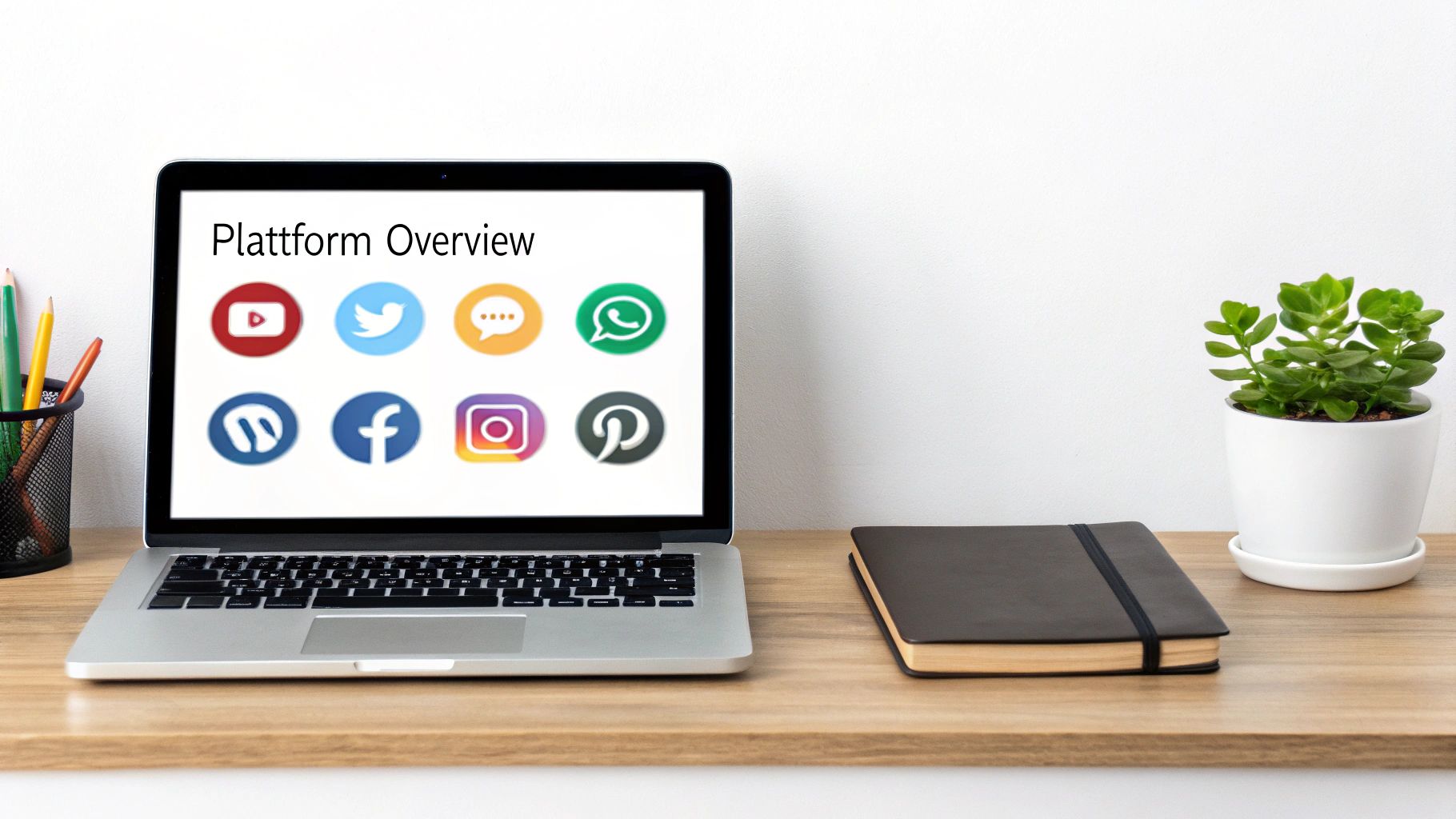
Let's get one thing straight: social media isn't some optional extra you can ignore. For small companies all over the UK, it’s a game-changing tool that delivers serious results. A smart social media strategy allows a local bakery to create more local buzz than a national chain or helps a solo consultant establish themselves as a go-to expert in their niche.
These platforms give you a direct line to the people you want to reach. You’re not just shouting into an empty room; you’re starting real conversations that build trust, create loyal customers, and generate sales, often for less than the cost of a few printed flyers.
The Untapped Potential for UK Businesses
Here's where it gets interesting. Despite how powerful these tools are, there's a huge opportunity waiting to be seized. In the UK, a staggering 70% of small businesses admit they aren't making the most of social media. This is happening while 4.9 billion people worldwide spend nearly 2.5 hours a day scrolling through these apps.
It's a massive oversight, especially when you can kick off targeted ad campaigns for as little as £5–£10 a day and reach thousands of potential customers.
What does this mean for you? By simply showing up with a clear strategy and a bit of consistency, you can leapfrog competitors who are still sitting on the fence. You don't need to be perfect from the get-go; you just need to get started.
Your social media isn't just another task to tick off. It's your most direct and powerful channel for connecting with your community and growing your business. Think of it as your launchpad for turning casual followers into your biggest fans.
Building Connections Beyond Your Local Postcode
While nurturing local connections is brilliant, social media completely tears down geographical walls. A talented ceramicist in Norfolk can suddenly find buyers all over the country, building a brand that resonates far beyond their workshop. This is particularly vital for businesses in regions like Norfolk, where a strong online presence can pull in tourism and drive e-commerce sales. Getting your head around social media marketing in Norfolk can give you a serious local advantage.
If you’re thinking about bringing in some outside help to manage all this, understanding social media agencies is a good place to start. But whether you do it yourself or hire someone, the core principles never change: be authentic, be genuinely helpful, and be consistent.
Platform Snapshot for UK Small Businesses
Choosing the right platform can feel overwhelming. This quick-reference table is designed to help UK small businesses figure out where to focus their energy first, based on who they want to reach and what they want to achieve.
| Platform | Primary UK Audience | Best For | Content Style |
|---|---|---|---|
| Broad (Ages 25-65+), strong in local communities | Community building, local events, customer service, targeted ads | Mix of text, images, videos, and links. More conversational. | |
| Younger (Ages 18-40), visually-driven users | E-commerce, lifestyle brands, visual portfolios (e.g., food, fashion, art) | High-quality images, short videos (Reels), Stories, aesthetics are key. | |
| Professionals, B2B decision-makers | B2B networking, establishing expertise, recruitment, company news | Professional, industry-focused articles, career insights, case studies. | |
| X (Twitter) | News junkies, tech-savvy users, customer service queries | Real-time updates, breaking news, public conversations, quick support | Short, snappy text posts, polls, GIFs, and breaking news links. |
| TikTok | Gen Z and Millennials (Ages 16-34) | Entertainment, trends, user-generated content, creative brand personality | Short-form, vertical videos with music and effects. Authentic and fun. |
| Predominantly female (Ages 25-50), planners | Driving website traffic, visual discovery for products (e.g., home decor, recipes) | High-quality, inspirational "Pins" (vertical images and videos) with links. |
Don't feel you have to be everywhere at once. The best approach is to pick one or two platforms where your ideal customers hang out and master them first. Once you've built momentum, you can always expand.
Choosing Where to Plant Your Flag
Let’s bust a common myth right away: you don't need to be on every social media platform. In fact, that's one of the fastest routes to burnout and getting nowhere. Spreading yourself too thin is a classic rookie mistake. The smarter move is to pick just one or two platforms and truly master them.
Think of it like choosing a physical spot for your shop. You wouldn't open a high-end jewellers in a student union, would you? Or a skate shop on a quiet residential street. The same logic applies online. Your goal is to find where your ideal customers are already spending their time and set up your digital stall right there.
Ask the Right Questions First
Before you even dream of creating a profile, you need to put on your strategist hat. A B2B tech firm in Manchester has a completely different audience than a boutique clothing shop in Brighton. The tech firm will likely find its best leads on LinkedIn, while the boutique can build a brand and drive sales with the visual storytelling of Instagram.
Start by asking yourself these critical questions:
- Where do my customers actually hang out online? Don't guess. Think about their age, job, and what they're into.
- Which platform best showcases what I sell? If you sell beautiful cakes or handmade furniture, Instagram and Pinterest are no-brainers. If you offer professional services, LinkedIn is your arena.
- What can I realistically manage? Be honest about the time and resources you have. It's far better to be a star on one platform than to be a ghost on five.
Getting this right is a fundamental part of a solid digital strategy. Understanding the 'why' behind your choice is one of the key reasons why digital marketing is so important for growing your business.
Match the Platform to Your People
Let's get practical. An electrician or plumber could find huge value in local Facebook Groups. It’s a perfect place to answer questions, share photos of completed jobs, and build a reputation as the go-to expert in their community. Their content would be helpful, down-to-earth, and focused on local needs.
A freelance graphic designer, on the other hand, would find their tribe on platforms like Instagram or Behance. For them, these visual networks are a living portfolio where they can show off their work, attract new clients, and connect with other creatives. Their content needs to be polished, aesthetic, and inspirational.
This simple decision tree gives you a great starting point for mapping your audience to the right platform.
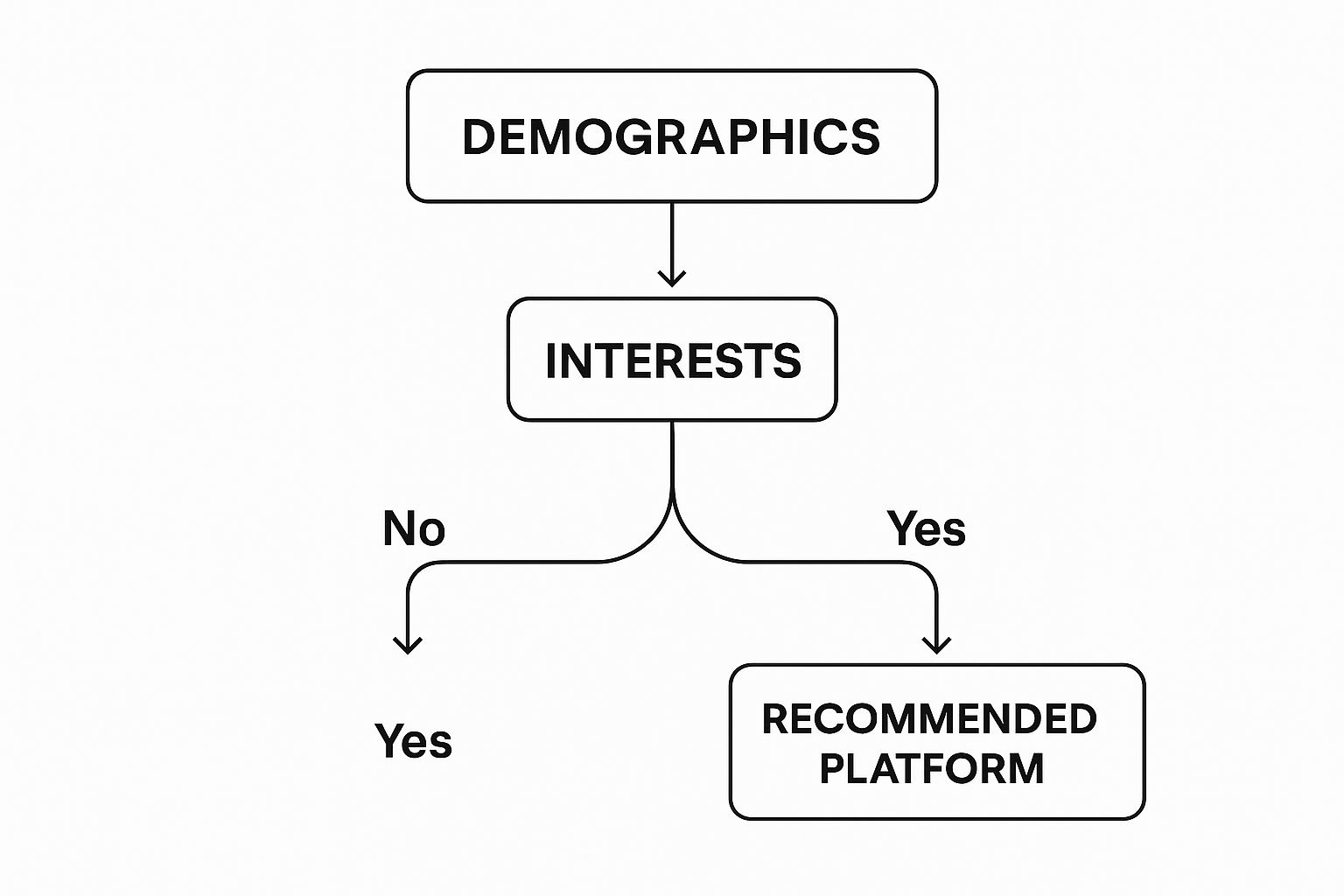
As you can see, starting with a clear picture of your customer is the surest way to pick a channel that will actually work for you.
For many UK businesses in retail, fashion, or lifestyle, Instagram is a must. It boasts a huge UK user base of 34.71 million people. On top of that, 81% of retailers already use it to connect with customers. Its largest audience is aged 25-34, making it a powerhouse for reaching young adults with visual content that gets them talking—and buying. You can dig into more UK social media statistics on Talkwalker.com if you're curious.
Choosing a platform isn't about what's popular; it's about what's profitable for your business. Focus your energy where your customers are listening, and you'll get a far greater return on your time and effort.
At the end of the day, it's about making a deliberate choice. Don't jump on TikTok just because it’s trending if your audience of corporate executives is networking on LinkedIn. By carefully selecting where to plant your flag, you ensure your social media efforts are focused, sustainable, and, most importantly, effective.
Building a Content Plan That Actually Works

Do you ever feel like you're stuck on a content treadmill? That constant, nagging thought of "what on earth am I going to post today?" is exhausting, I know. But the secret to escaping this cycle isn't about posting more; it's about planning smarter. A solid content plan is your ticket to consistency without the burnout.
The key is to shift your mindset from thinking post-by-post to thinking in themes. This is where the magic of 'content pillars' comes into play.
Find Your Content Pillars
Content pillars are simply the 3-5 core topics that your business is all about. These are the broad subjects your audience genuinely cares about and that you can speak on with real authority. Think of them as the foundation for everything you post.
Let's imagine you run an independent estate agency. Instead of just posting random house photos, your strategy could be built on pillars like these:
- First-Time Buyer Tips: You could answer common questions, demystify industry jargon, and offer guidance to nervous buyers.
- Local Market Updates: This is where you'd share insights on house prices, which neighbourhoods are hot, and what’s happening in the local community.
- Home Staging Secrets: You can provide practical, DIY advice on how to make a property look its absolute best before a viewing.
Just like that, you have three deep wells of inspiration. Each pillar can spark dozens of specific post ideas, from short video tips and infographics to detailed guides and client success stories. This approach turns content creation from a daily chore into a structured, repeatable system.
A handful of strong content pillars is worth more than a hundred random ideas. They give you focus, help build your authority, and make planning infinitely easier.
Your Secret Weapon for Getting Ahead
Once you've defined your pillars, your next best friend is content batching. This is the game-changing practice of creating a week's or even a month's worth of content in one dedicated session. Instead of trying to force creativity every single day, you block out one afternoon to get it all done.
During your batching session, you can write captions, design graphics, and film short videos for multiple posts at once. This isn't just a time-saver; it’s a sanity-saver. It pulls you out of a reactive mode and puts you in a proactive one, freeing up your daily schedule to focus on engaging with your audience and actually running your business.
To get started with a structured approach, a resource like this 30-day content bank guide can provide a fantastic framework for planning ahead.
Creating Content That Doesn't Look Homemade
You don't need to be a professional designer to create visuals that look polished. These days, there are some incredible, user-friendly tools that put professional-grade design power right at your fingertips.
- For Graphics: Tools like Canva are a godsend for small businesses. They offer thousands of templates for social media posts, stories, and infographics. You can easily drag and drop your own branding, colours, and fonts to create a consistent look.
- For Videos: Don't underestimate the power of your smartphone. When you combine it with simple editing apps like CapCut or InShot, you can create really engaging Reels and short video clips. My advice? Focus on good lighting and clear audio—that's often more important than having a fancy camera.
Remember, a staggering 91% of audiences now prefer video explainers to written content. Turning one of your blog posts into a quick "how-to" video or a case study into a testimonial clip can dramatically increase its reach and impact.
By combining strong content pillars with the efficiency of batching and the power of user-friendly creative tools, you build a content engine that truly works for you. This frees you from the daily panic and ensures your social media marketing is consistent, professional, and genuinely effective.
How to Turn Followers Into a Community
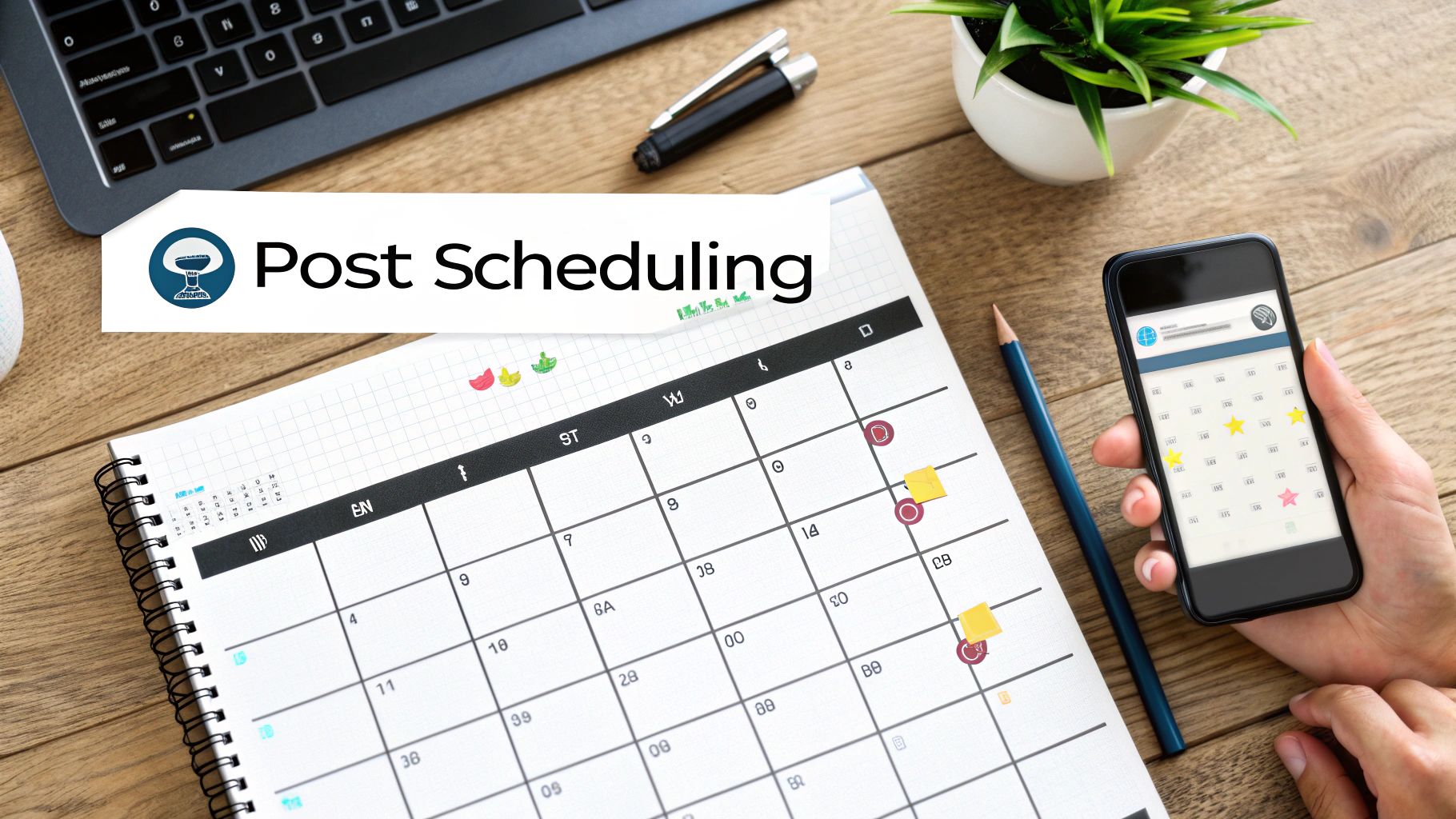
It’s so easy to get fixated on follower counts and likes. We all do it. But honestly, those are often just vanity metrics. The real magic of social media for a small business isn't about collecting passive followers; it's about building a vibrant, engaged community around your brand. This means you have to stop broadcasting messages and start having real conversations.
When your followers feel like they’re part of something special, that’s when you know you’ve succeeded. This guide will walk you through the practical steps to turn your audience from silent observers into active participants and, eventually, loyal advocates for your business.
From Posting to Conversing
The first mental shift you need to make is this: see your posts not as the finish line, but as the starting pistol for a conversation. Every caption, video, and image should be crafted to invite some kind of response.
Instead of just stating facts, start asking open-ended questions. A local café owner, for example, could move beyond posting "Here's our new latte" and ask, "If you could invent a new autumn-themed drink, what would it be?" That simple change invites creativity and personal stories, not just a one-word answer.
This approach transforms your feed from a one-way street into a lively forum where people genuinely feel seen and heard.
Make Your Audience Part of the Story
People love to feel included. One of the best ways I’ve found to foster this is by giving your audience a real say in what you do. Simple tools like Instagram or Facebook polls are incredibly effective for this.
Think about these real-world scenarios:
- A local bookshop could run a poll asking which classic novel should be their "Book of the Month."
- A personal trainer might ask their followers what kind of workout tutorial they'd like to see next.
- A candle maker could let their community vote on the next scent to be developed.
This does more than just generate a few clicks; it gives your audience a sense of ownership. They become co-creators in your brand's journey, making them far more invested in your success. For small businesses, transforming followers into a thriving community is crucial for long-term engagement; a comprehensive guide to building online communities can provide a fantastic blueprint for this entire process.
Stop chasing numbers and start cultivating relationships. A community of 100 engaged fans who trust you is infinitely more valuable than 10,000 silent followers who don’t.
The Art of the Meaningful Reply
How you respond to comments is just as important as the content you post. A generic "Thanks!" is better than nothing, sure, but a thoughtful reply can turn a casual commenter into a lifelong fan.
When someone leaves a comment, take a moment to look at their profile. Acknowledge what they've said specifically and, if you can, ask a follow-up question. If a customer posts a picture enjoying your product, don't just like it—share it to your Stories and thank them personally. This shows you're not just a faceless brand; you're a real person who values their input.
This level of personal interaction is a superpower for small businesses. It creates a level of customer intimacy that larger corporations simply can't replicate.
Encourage Your Customers to Be Your Marketers
One of the most powerful assets in community building is user-generated content (UGC). This is any content—photos, videos, reviews—created by your customers that features your brand. It’s authentic, trustworthy, and acts as incredible social proof.
So, how do you get more of it? You make it easy and rewarding.
- Create a unique hashtag: Come up with a simple, memorable hashtag that gives customers a way to tag their posts. A Bristol-based bakery, for instance, might use something like
#BakesInBristol. - Run a contest: Ask customers to share photos using your product for a chance to win a prize. This can create a real surge of content and excitement around your brand.
- Feature them regularly: Dedicate a spot on your feed or in your Stories to "Customer Features." This recognition is often a powerful motivator in itself.
Embracing UGC turns your customers into your most effective marketing team. It builds a cycle of engagement where real people share their genuine love for your brand, inspiring others to do the same. And really, that's the ultimate goal of community-focused social media.
Making Sense of Your Social Media Data
Let's be honest, social media analytics can look like a spreadsheet full of gibberish. It’s easy to get overwhelmed. But you don’t need a degree in data science to figure out what’s actually working.
The secret is to tune out the noise. Forget the mountain of metrics and vanity stats like follower counts. We're going to focus on the handful of numbers that tell you if your social media efforts are actually making a difference to your business. For most small businesses, this comes down to three things: who you’re reaching, how they're reacting, and if they’re taking the next step.
The Metrics That Truly Matter
You don't need to track dozens of different numbers. To get started, you only need to get a feel for a few key performance indicators (KPIs). Think of them as the vital signs for your social media health.
Here are the big three to keep an eye on:
- Reach: This is simply the total number of unique people who laid eyes on your post. It’s a great top-level indicator of how far your content is travelling and if you’re getting in front of new faces.
- Engagement Rate: This is all about how actively involved your audience is. It’s calculated by taking all the interactions (likes, comments, shares, saves), dividing that by your follower count, and multiplying by 100. A high engagement rate is gold—it means your content genuinely connected with people.
- Website Clicks (or Click-Through Rate): This is the acid test. How many people are actually clicking that link in your bio or post to visit your site, book a consultation, or buy something? This metric bridges the gap between social media activity and real business results.
Finding this information is usually straightforward. Platforms like Facebook and Instagram have built-in "Insights" or "Analytics" tabs right on your business profile. They present this data with helpful graphs that show your performance over time.
Turning Data Into Decisions: A Real-World Scenario
Let’s put this into practice. Imagine you're a local plumber based in Suffolk. For the past month, you’ve been posting two kinds of content on your Facebook page: slick photos of your shiny new tools and short 'before-and-after' videos from recent jobs.
When you check your Facebook Insights at the end of the month, this is what you see:
| Content Type | Average Reach | Average Engagement Rate | Website Clicks (to 'Get a Quote' page) |
|---|---|---|---|
| Tool Showcase Posts | 850 people | 1.5% | 3 |
| 'Before-and-After' Videos | 600 people | 7.2% | 25 |
The data tells a very clear story. Sure, the tool photos reached a few more people, but the 'before-and-after' videos blew them away where it counts. The engagement rate was almost 5 times higher, and critically, they drove over 8 times more clicks to your quote page.
This isn’t just interesting trivia; it's a direct instruction from your audience. They're telling you they don't care so much about your new wrench; they care about the sparkling new bathroom you can deliver. Your strategy is now crystal clear: make more 'before-and-after' videos. This is how you move from guesswork to making smart decisions that impact your bottom line. It's also a fantastic way to boost your local visibility, which is a key part of an effective local SEO strategy for your small business.
Don't let analytics intimidate you. Think of your data as direct feedback from your customers. They are telling you exactly what they want to see more of. All you have to do is listen and adapt.
Understanding the Bigger Picture
It’s also smart to keep one eye on the wider market. For instance, the social media advertising market in the UK is massive and still growing, expected to hit £9.95 billion in revenue. Facebook is still a powerhouse with 38.3 million users in the UK, and its ad reach grew by 3.2% in the last year.
However, it's worth knowing that younger audiences (18-24) are spending less time there, averaging just 15 minutes a day. This suggests that if you’re targeting that demographic, you should probably be active on other platforms too. You can discover more about UK social media trends on Sproutsocial.com.
By blending your own performance data with these broader market insights, you build a much stronger picture of where to put your time and energy. It’s what turns your social media from a hopeful experiment into a reliable engine for growing your business.
Common Questions from Small Business Owners
Even with the best plan, the day-to-day reality of social media marketing always throws up a few curveballs. When you're in the thick of it, you need straight-talking, practical answers, not corporate jargon. This section tackles some of the most common hurdles I see small business owners face, giving you clear advice to handle them like a pro.
Think of this as your quick-reference guide for those moments when you're not quite sure what to do next. From dealing with tricky feedback to figuring out your posting schedule, these insights come from years of real-world experience.
How Much Should a Small Business Budget for Social Ads?
This is the big one, isn't it? The question I hear more than any other. And the answer is refreshingly simple: start small and focus on learning, not earning. You absolutely do not need to find thousands of pounds to make an impact with social media ads.
Honestly, a daily budget of just £5-£10 on a platform like Facebook or Instagram is plenty to get started. In the beginning, your goal isn't immediate sales. It’s to gather data. You’re trying to figure out which ad creative, which bit of text, and which audience group gets you the most results for your money.
For that first campaign, stick to one clear goal. Maybe you want to drive traffic to a specific product page or get more eyes on a new blog post. Let it run for a week or two and keep a close eye on the results. Once you spot a combination that works, that's when you can feel confident about increasing your spend.
What Is the Best Way to Handle Negative Comments?
Let's be honest, seeing a negative comment stings. It can feel personal. Your first instinct might be to lash out or hit that delete button and pretend it never happened. Please don't. A bit of public criticism is actually a golden opportunity to show everyone else that you're a professional, responsive business that truly cares.
Here’s a simple process that works every time:
- Acknowledge it quickly and publicly. Don't let it fester. A prompt reply shows the customer (and everyone else) that you're listening.
- Say sorry and show you understand. Start with a simple, "I'm so sorry you had a bad experience." It validates their feelings and immediately de-escalates the situation.
- Take the conversation offline. You don't need to have a back-and-forth debate in public. Offer to fix it privately. Try something like, "I want to make this right for you. Could you please send us a direct message with your order number so I can look into this personally?"
This approach turns a potential disaster into a public display of fantastic customer service.
Your response to one negative comment isn't just for that one person; it's a message to every potential customer who sees it. Handle it with grace, and it becomes one of your best marketing assets.
How Do I Find the Best Times to Post?
You’ve probably read guides that suggest posting at lunchtime (12-2 PM) or in the evening (7-9 PM). While those are decent starting points, the real answer is much more specific. The best time to post is whenever your unique audience is most active online.
And the good news is, you don't have to guess. Your analytics hold all the answers.
Platforms like Instagram and Facebook have built-in "Insights" or analytics tools that show you exactly which days and hours your followers are scrolling. This data is pure gold because it’s not generic—it’s about your customers and your community.
Make a habit of checking your insights weekly. You might be surprised. Perhaps your audience is most engaged on a Sunday evening, or during their Wednesday morning commute. Test posting at these peak times and see what happens. A little experimentation based on your own data will always beat following a generic schedule.
Feeling like you could use a partner to manage all this and more? The team at Ibertech Solutions Limited offers expert social media management and digital marketing strategies designed specifically for small businesses in Norfolk and Suffolk. Let us help you build a powerful online presence. Learn more and get in touch with us today.



